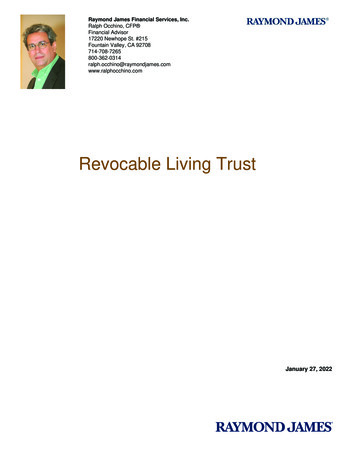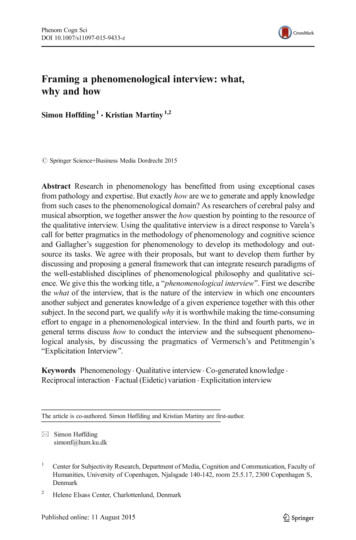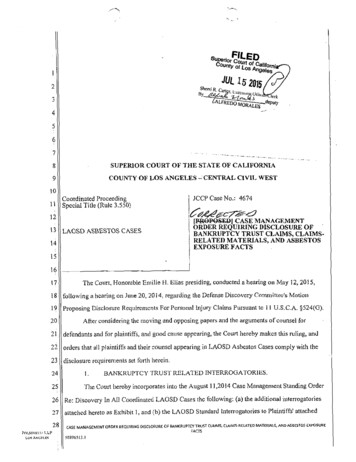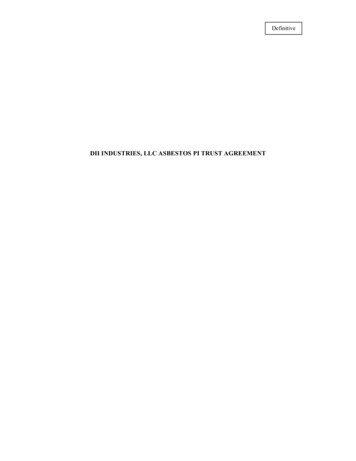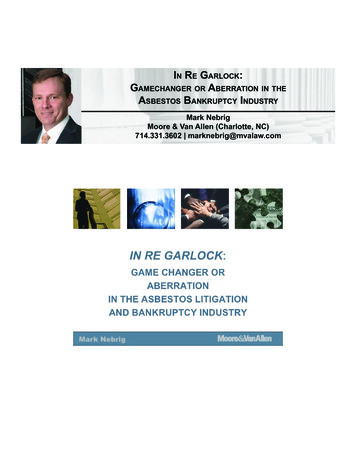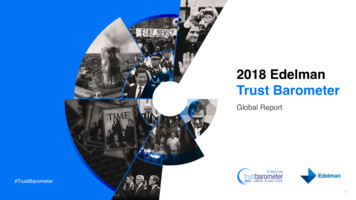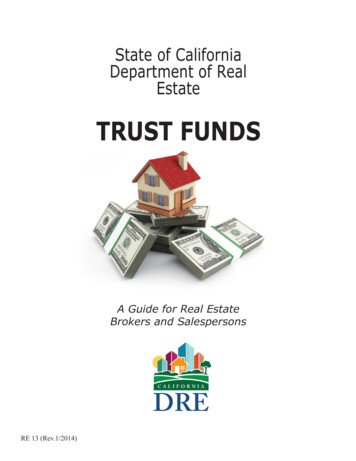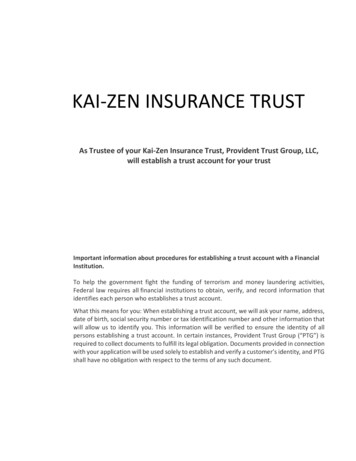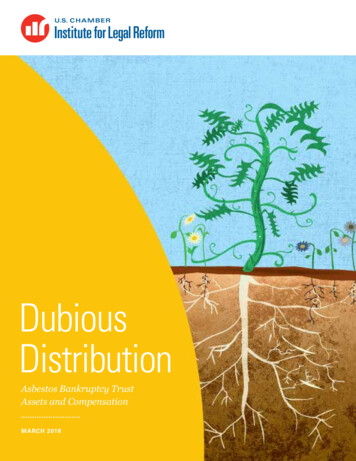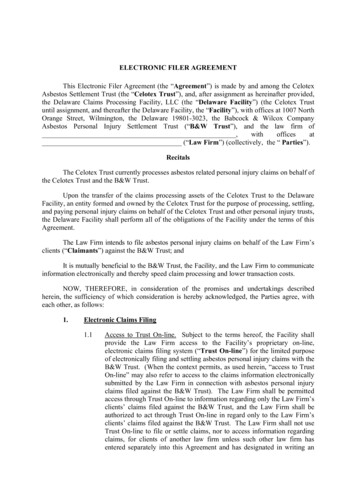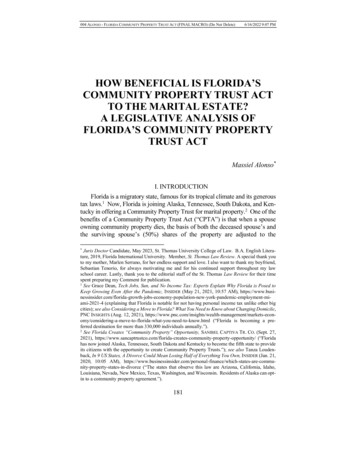
Transcription
TRUST: A PHENOMENOLOGICAL STUDY OF LEADERS AND VOLUNTEERS INLDS SEMINARIES AND INSTITUTESA Dissertationpresented tothe Faculty of the Graduate Schoolat the University of Missouri-ColumbiaIn Partial Fulfillmentof the Requirements for the DegreeDoctor of Educational Leadership and Policy AnalysisbyJOHN LAWSONDr. Cynthia MacGregor, Dissertation SupervisorMAY 2014
Copyright by John Lawson 2014All Rights Reserved
The undersigned, appointed by the dean of the Graduate School, have examined thedissertation entitledTRUST: A PHENOMENOLOGICAL STUDY OF LEADERS AND VOLUNTEERS INLDS SEMINARIES AND INSTITUTESpresented by John Lawson, a candidate for the degree of doctor of education, and herebycertify that, in their opinion, it is worthy of acceptance.Dr. Cynthia J. MacGregorDr. Jason AndersonDr. Beth HurstDr. Robert Watson
DedicationTo Liz, for your support and sacrifice.To Katie, Anna, Sara, Emily, and Sam, who I cannot think of without smiling.
ACKNOWLEDGEMENTSI assumed the completion of a dissertation had more of a closure feel than it reallydoes. What I have found instead is an increased awareness that there is much more tolearn and to understand. To be learned is good if we hearken to the counsels of God (2Nephi 9:29). Throughout this entire process I have felt my mind expanded and my desireto be better increased. I am grateful to a Heavenly Father who has confirmed truth in mymind and heart and inspired to me to act.I would never have been able to complete this project without the guidance,encouragement, and patience of Dr. Cindy MacGregor. Taking on someone with only areligious education background meant extra work and time for her. I continue to beimpressed by what she knows, but even more by the kind of person she is.I would also like to thank my committee for their time and efforts in making mydissertation the best it could be. A special thank you to Dr. Bob Watson for alwaysreminding me of the practical implications of what I am studying. Dr. Beth Hurst has theAPA manuals memorized. Despite the multitude of errors she found, she always had asmile and words of encouragement. Dr. Jason Anderson’s suggestion concerningleadership theory during the research proposal process expanded my views on leadershipand what it truly means. Dr. Don Christensen and Dr. Jared Jepson have been patientreaders and sounding boards.Finally, I thank my family who would not let me forget that I am a husband andfather first, ahead of being a doctoral student. I have been blessed over the course of thispursuit to not only maintain a strong relationship with my wife, 4 daughters and 1 son,but also increase and reinforce those relationships. We are a better family because ofengaging in this educational endeavor together.ii
TABLE OF CONTENTSACKNOWLEDGEMENTS . iiLIST OF FIGURES . viABSTRACT. viiChapter1. INTRODUCTION .1Statement of Problem .3Purpose of the Study .6Research Questions .7Conceptual Framework .7Design and Methods .10Assumptions.11Definition of Key Terms .13Significance of Research for Leadership Practices .15Summary .162. REVIEW OF RELATED LITERATURE .17Historical Perspective of Leadership and Trust .19Theories and Models of Leader-Follower Relationships .28Defining Trust .37Recognizing Trust .45Building Trust .49Conclusion .55iii
3. RESEARCH DESIGN AND METHODOLOGY .59Design for the Study .61Data Analysis .66Validity .68Limitations .69Summary .704. DISCUSSION OF FINDINGS .72Volunteer Perception of Their Trust of Coordinators .73LMX-7 Data Results .74Effective Teaching .76Helpful or Discouraging Training .77Genuine or Self-Serving Administrating .81Summary of Volunteer Perception of Their Trust of Coordinators .95Coordinator Perception of how they are Trusted by Volunteers .98LMX-7 Data Results .99Superior Teaching .101Implementation of Coordinator Instruction .105Maintaining Relationships .109Summary of Coordinator Perception of how they are Trusted by Volunteers .112Chapter Summary .114iv
5. DISCUSSION AND CONCLUSIONS .115Purpose of the Study .116Design and Procedures .116Conclusions .117Integrated Findings of the Study .119Discussion .122Limitations .125Recommendations for Practice .127Implications for Future Research .129Concluding Thoughts .131REFERENCES .132APPENDIXA. INFORMED CONSENT .143B. RECRUITMENT EMAIL.145C. MODIFIED LMX-7 QUESTIONAIRE .146D. VOLUNTEER INTERVIEW PROTOCOL .149E. COORDINATOR INTERVIEW PROTOCOL .150VITA .151v
List of FiguresFigure1. Integrative Model of Trust .352. Volunteer Results of LMX-7 Survey .753. Summary of Volunteers Perception of Their Trust of Coordinators .974. Coordinator results of LMX-7 Survey .1005. Summary of Coordinator Perception of how they are Trusted by Volunteers .1136. Coordinator and Volunteer Trust .123vi
TRUST: A PHENOMENOLOGICAL STUDY OF LEADERS AND VOLUNTEERS INLDS SEMINARIES AND INSTITUTESJohn LawsonDr. Cynthia J. MacGregor, Dissertation SupervisorABSTRACTThe researcher conducted a qualitative student to develop a deeper understandingof how volunteers and leaders in the Seminaries and Institute (S&I) program of TheChurch of Jesus Christ of Latter-day Saints perceived trust between one another.Participants were coordinators and volunteer seminary and institute instructors from theUS Southern Plains area of S&I. Data were collected from participant interviews andsurvey responses.The researcher identified three overarching categories as relevant to volunteerperception of trust in coordinators: effective teaching, helpful and discouraging training,and genuine or self-serving administrating. Further the researcher identified threeoverarching categories as relevant in recognizing the way coordinators perceived theywere trusted by volunteers: superior teaching, implementation of coordinator instruction,and maintaining relationships.The findings of this study have implications for coordinators and volunteers wholabor within the S&I organization. One glaring finding of this study was that theantecedents of trust, namely ability, benevolence, and integrity, were more readilyvii
perceived among volunteers and coordinators who had personal, informal communicationwith each other.viii
CHAPTER ONEINTRODUCTION TO RESEARCHOne defining and unifying characteristic of human beings is the opportunity to beengaged in relationships with one another. Though this is not a groundbreaking findingor particularly unique and fascinating, the exchanges and interactions that exist withinthese relationships have been a spark of curiosity and intrigue among philosophers,theologians, scholars, poets, and leaders. As these individuals have considered countlesstypes and forms of relationships, their thoughts and study have become focused on whatmakes successful relationships. The characteristic of trust is frequently referenced bydiverse populations and in diverse disciplines making trust a universal characteristic ofrelationships and not bound to a specific group, social system, or culture.Confucius, in the sixth and fifth century BCE in China, believed that rulers needthree resources: weapons, food, and trust. He went so far to say that if rulers could notobtain all three, they should prioritize these resources by first giving up weapons and thenfood but should never relinquish trust. He stated, “Without trust we cannot stand!”(O’Neill, 2002, p. 3).Confucius was not without detractors in the world of philosophy. Nearly 2000years after Confucius postulated concerning trust, Machiavelli (1984), an Italianphilosopher believed that fear provided a stronger influence in relationships than trust. Inwriting on leadership, he provided an example of royalty being both loved and feared, butif both were not possible, then he should choose to be feared by his subjects rather thanloved. He stated, “Love is held together by a chain of obligation which, since men are1
wretched creatures, is broken on every occasion in which their own interests areconcerned; but fear is sustained by a dread of punishment which will never abandon you”(Machiavelli, 1984, p. 54).Theologians have considered the role of trust in religious faith for centuries.Judeo-Christians find the Bible replete with direct and indirect references to trust.Ironically, the counsel from the pages of this sacred text often indicate that man shouldnot place trust in other men or objects over that of God. In the Old Testament, Jehovahinvited believers to, “Trust in the Lord with all thine heart; and lean not unto thine ownunderstanding” (Proverbs 3:4, King James Version). Further, in the New Testament,Jesus Christ rebuked those who place trust in inanimate objects rather than in theirrelationship with deity when he emphatically proclaimed, “Children, how hard is it forthem that trust in riches to enter into the kingdom of God!” (Mark 10:24).Perhaps trust, as it relates to the world of business, can be observed and tracedback to the coffee shops and pubs of 17th century London, England. It was here that theadvent of insurance and the idea of stock exchanges began. Merchants, shipping moguls,and bankers would meet in these locales to discuss business mergers, commodity prices,trade secrets, and general information about the state of commerce. Edward Lloyd’scoffee house was the customary locale for mariners interested in insuring their sea vesselswhile Tom’s and Causey’s Pub provided a place for mercantile owners to price andpurchase fire insurance to protect their business (Michie, 1999). Interestingly, it was theatmosphere of such places that made them informal but reputable places to do business.Individuals within the walls of such establishments were described as being affable andfriendly, thus making the process of doing business with others appear to be less risky. In2
other words, because of the disposition of those buying and selling, trust seemed to be anatural sentiment (Dickson, 1993).Though relationships are often formed by circumstance and choice, such as therelationships found in the Tom’s and Causey’s Pub, what happens in these relationshipsis often the result of what is perceived between the individuals involved. More commonthan recognizing the results of research on trust is the personal recognition andimportance humans seem to naturally have for trust in relationships. Trust, in one degreeor form, seems to be an inherent part of all human relationships. Though trust betweenindividuals in a relationship is not requisite for relationships to exist, the absence of trustwill limit exchanges in those relationships (Cosner, 2009; Moye, Henkin & Egley, 2005;Tschannen-Moran & Hoy, 2004).Often, when trust is studied in light of relationships, it is from the perspective offamilies and other social groups or interactions. Within the past 50 years however,researchers have begun to look at how trust affects attitudes and dispositions in otherareas such as schools, jobs, and places of worship. Not surprisingly, these researchersfound benefits to trust in multiple disciplines and circumstances (Deutsch, 2009;Gillespie & Mann, 2004). One area that researchers have explored, and which isintriguing to view through the lens of trust, is employee motivation. Employeemotivation research may be valuable to CEOs of large corporations and to smallbusinesses seeking to develop and grow (Rousseau, Sitkin, Burt & Camerer, 1998).Leaders have implemented bonuses of money, stock options, working fromhome, insurance benefits, and paid vacation in an effort to win the hearts of theiremployees in order to motivate them to perform at high levels. However, providing3
monetary incentives to an individual who has no monetary needs will not always produceintended results (Barnard, 2011). Similarly, providing future stock options to employeesstruggling to feed their family and in need of a raise in salary may actually distance themfrom leaders. These employees may feel their leader is out of touch, while the leaderwallows in the thought that they have ungrateful employees. Yet when leaders simplyand sincerely trust employees and employees perceive trust, then performance and qualityconsistently improve (Ernst & List, 2004).Large non-profit organizations, such as churches, rely on volunteers to assist inaccomplishing their mission and objectives. Often motivated by the mission andobjective of the organization, volunteers engage in important and often times, skilldemanding work. Organizations comprised of volunteers sometimes may structurallyresemble organizations made up of paid employees. Occasionally, leaders are funded bythe organization and given the task of directing the work of the volunteers. These leadersoften rely on the same skills and characteristics, including trust, used by leaders in forprofit organizations to promote growth, development and realization of the organizationalpurposes. Leaders and volunteers in non-profit organizations desire to feel trusted yetmay show or perceive trust differently than volunteers or employees in for-profitorganizations because of the nature of the circumstances in which they work.Statement of ProblemThe results of numerous studies such as Chen, Lam, and Zhong, (2010) andMayer, Davis, and Schoorman (1995) have indicated that trust is a key factor in personalrelationships as well as organizational outcomes. The extent of the studies presented, hasnot stifled researchers’ attempts at examining trust; rather it has shifted the way trust can4
be explored. Various scholarly definitions, along with personal and societal viewscombine to make the study of trust either broad or ambiguous depending on the view ofthose interested in the topic. The definition of trust used in this current study is,The willingness of a party to be vulnerable to the actions of another party basedon the expectation that the other will perform a particular action important to thetrustor, irrespective of the ability to monitor or control that other party. (Mayer etal., p. 712)Trust is a social phenomenon that occurs between individuals or groups of people;therefore it is difficult to actually measure and also apply those measurements acrossvarious organizations (Mayer et al., 1995). Leaders, who implement research-suggestedactions related to the issue of trust, may find that the results described within a study arenot applicable to their particular organization.Non-profit organizations may struggle more than others at using previous researchto examine issues of trust. The vast majority of research concerning trust inorganizations examines it from the perspective of for-profit businesses that provide payor other extrinsic benefits for services. Organizations such as the Seminaries & Institutesof Religion (S&I) organization examined in this study are not structured to provide suchbenefits, nor would those benefits necessarily create desired outcomes.The dearth of research surrounding non-profit organizations and trust compoundsthe problem of determining what findings and what conclusions leaders within S&I canimplement in their own leadership practice. Additionally, there appears to be no researchrelative to trust done specifically on religious organizations involved in religiouseducation similar to that which takes place within S&I. Leaders in S&I interested in5
understanding trust are left to sift through previous research on trust trying to identify anystudy that seems relevant to their work.Currently, over 400 coordinators are employed by S&I to work with and provideleadership for over 40,000 volunteers throughout the world (Seminaries and Institutes ofReligion, 2013, p. 2). However, coordinators are relatively untrained in working withvolunteers prior to being assigned a specific area. Most coordinators were employed asfull-time seminary or institute teachers, and did not have experience working with ortraining volunteer teachers.No study was found that determined how or if coordinators and volunteers areable to perceive relationships of trust between each other. Any evidence that is present isanecdotal at best and is not formally collected. Currently, no research-identifiedindicators have been found that show how volunteers perceive trust with coordinators.Until such indicators become known, administrators will make coordinating assignmentsbased upon a subjective opinion of a desired standard.PurposeThe intent of this concurrent mixed methods study was to identify howcoordinators and volunteers within S&I perceive trust between each other and identify theactions these perceptions are based upon. In this study, the LMX-7 (Northouse, 2010)survey was used to measure personal perceived trustworthiness of coordinators andvolunteers in S&I. At the same time, perceptions of trust among these two groups wereexplored using qualitative interviews conducted by the researcher. The reason forcombining both quantitative and qualitative data was to better understand this researchproblem by converging both quantitative and qualitative detailed data.6
Research QuestionsWithin the context of this study the following three research questions were posedas they relate to the constructs of trust perceived by leaders, trust perceived by volunteers,and evidence of action that indicates that trust is present between leaders and volunteers.1. How do volunteers in a non-profit religious education organization perceivetheir trust of coordinators in the organization?2. How do coordinators in a non-profit religious education organization perceivethey are trusted by volunteers in the organization?Conceptual FrameworkAn effective leader ponders “What are the needs of the people I lead?” Anineffective leader may ask, “With all of these lazy folks I am in charge of, how will I getanything done?” Bolman and Deal (2008) asserted, “Managers often fail to get thingsdone because they rely too much on reason and too little on relationships” (p. 218).Bolman and Deal’s human resource frame combines theories and organizational analysistools to show how leaders and organizations succeed or fail based upon how they relatewith followers. Leaders may be viewed by followers or even view themselves asoppressive, militant and non-communicative. Additionally, they can be viewed as beingexpectant of employees to put in their time, do what they are told and then go home.However, the human resource frame also provides ample room for theories that promotethe idea that leaders and followers can work together in fruitful and productive ways.According to Bolman and Deal (2008), the basic tenets of the human resource frame arebuilt on the assumptions that:1. Organizations exist to serve human needs rather than the reverse.7
2. People and organizations need each other: organizations need ideas, energy,and talent; people need careers, salaries, and opportunities.3. When the fit between individual and system is poor, one or both suffer:individuals will be exploited or will exploit the organizations, or both willbecome victims.4. A good fit benefits both: Individuals find meaningful and satisfying work, andorganizations get the talent and energy they need to succeed. (p. 102)McGregor (1960) developed a relational theory, included within Bolman andDeal’s (2008) development of the human resource frame, which examined interactionsbetween employers and volunteers and entitled it Theory X and Theory Y. Thesetheories identified two different positions or lenses though which a leader may viewfollowers. Theory X leaders generally distrust followers while Theory Y leaders displayhigh levels of trust with followers. Trust is generally displayed by leaders in the form ofcollaboration and shared responsibilities. Theory Y leaders rely on followers to getimportant and meaningful jobs done. They encourage followers to use ingenuity toaccomplish tasks rather than relying on specific or rigid guidelines. Followers of aTheory Y leader are viewed as assets to the organization who want to do a good job andpromote success within the organization.McGregor (1960) believed manager distrust of employees is born out of a beliefthat employees are trying to take advantage of the leader and the organization. Likewise,employees’ distrust of managers was created by a sense that managers do not care aboutsubordinates and are only striving to increase the bottom line. Subsequent research based8
upon McGregor’s theory has shown outcomes of both Theory X and Y leadershippractices (Costigan, Ilter, & Berman, 1998).McGregor (1960) only examined general perceptions of workers which left anatural gap in research considering how leaders perceive themselves in relation to trust.The LMX theory (Northouse, 2010), though relatively new and not studied as extensivelyas other leadership models, addressed the question of how leaders perceive they aretrusted by followers. The LMX theory explains how leaders use some followers (ingroups) more than others (out-groups) to accomplish organizational objectives. Thetheory presents the idea that this imbalance is caused by a leader judgment of followers’capability to complete tasks (Northouse, 2010).Offering a different perspective, Chen et al. (2010) used LMX as a lens to studyperceptions of trust that followers had of leaders and how leaders perceived followersemotional intelligence. This quantitative study provided a different way for research toview LMX. Leader-member exchange studies are usually focused on competence ofsubordinates, but Chen et al. viewed LMX through the lens of trust. Their researchindicated that leaders trusted followers who they perceived to be emotionally intelligent,while followers found competent leaders to be trustworthy as well.Trust is difficult or simple to study depending on the definitions used to examineit. Until the 1990s many studies viewed trust through a transactional lens. For example,Axelrod (1984) believed that trust could only exist if both parties displayed trust. A laterstudy provided a definition of trust that was used in this study as simply a willingness toengage in risks based upon expected behaviors of others (Schoorman, Mayer & Davis,2007). Researchers have the freedom to define and view trust in whatever way they see9
fit. The wide scope by which trust may be viewed can serve to stifle or invalidate studieson trust; however, a varied view of trust may also serve to expand issues of trust amongmultiple organizations and circumstances.Research such as Mayer et al. (1995) and Sahin (2012) identified multipleindicators of trust between leaders and followers. Just as trust is perceived rather thanobjectively identifiable, so too are the indicators that reveal trust. The study of trust willnever become definitive or obsolete as long as there are differences in character amongindividuals and organizations. Leaders who maintain a working knowledge of what trustis and what it looks like in their organization may be surprised when that sameknowledge is not applicable in another organization. Research that identifies crossorganizational principles related to trust, while expecting and petitioning leaders to adaptthose principles into practice, will be of great worth to individuals seeking to develop andunderstand trust.Design and MethodsThe research questions provided previously were addressed using a mixedmethods approach. This phenomenological study of leaders and volunteers in theSeminaries and Institutes of Religion program employed three methods of data collection.A slightly modified version of the LMX-7 (Graen, & Uhl-Bien, 1995) survey instrumentwas used to collect quantitative data from 17 coordinators and 84 volunteers. Individualinterviews were also held with both leaders and volunteers. These interviews weretranscribed and analyzed relative to the research questions put for in this study.10
AssumptionsInherent in this study were potential problems that were identified and mitigatedby the researcher. These problems ranged from conflicts of schedules with participants topersonal biases of the author. Both problems associated with the study and biases of theresearcher are discussed in the section.Potential ProblemsThe organization researched in this study is directly affiliated with The Church ofJesus Christ of Latter-day Saints (LDS Church). A culture of volunteerism is prevalentwithin the LDS Church because there are no paid positions in its congregations ofworship. This culture creates challenges for researchers because members are not quickto be openly critical of others actions. An oft-heard refrain in the church is, they aredoing the best they can or you get what you pay for. Contrary to this cultural norm,coordinators in S&I are paid for their services yet work mainly with volunteers. It is rarefor church members to interact with any paid LDS Church employees at any time duringtheir membership. A potential problem in this study, caused by a culture of acceptinganother’s best efforts, is that of straightforwardness in answers to survey and interviewquestions. Coordinators
LDS SEMINARIES AND INSTITUTES John Lawson Dr. Cynthia J. MacGregor, Dissertation Supervisor ABSTRACT The researcher conducted a qualitative student to develop a deeper understanding of how volunteers and leaders in the Seminaries and Institute (S&I) program of The Church of Jesus Christ of Latter-day Saints perceived trust between one another.
